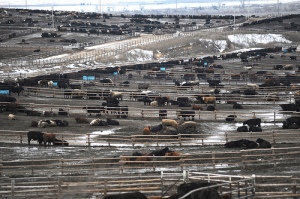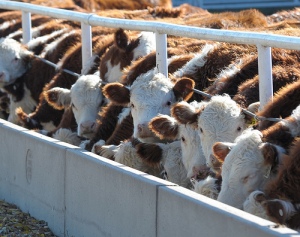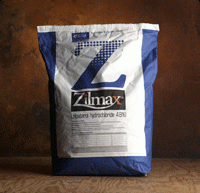
Cattle fatigue syndrome is not a new phenomenon, said Dan Thomson, K-State veterinarian. The swine industry discovered pig fatigue syndrome in the past, where stress played a role in animal mobility at packing facilities. Click image for original.
MANHATTAN, Kan. – In agricultural production, maintaining a level of excellence that includes environmental sustainability, animal welfare and food safety, while keeping food affordable for consumers is top-of-mind for many farmers and ranchers, as well as the researchers looking to help them find solutions to ensure this level of excellence.
As consumers shop at their local grocery stores and markets, they might notice that beef products are double or triple the price of other protein sources, and rightfully so, might hold beef to an even higher standard of excellence, said Dan Thomson, Kansas State University veterinarian, professor and director of the Beef Cattle Institute.
“Beef is one of the purest, most wholesome and most humanely raised forms of protein that we produce worldwide,” Thomson said. “As a beef industry, we are being asked day in and day out to take a holistic view of technology.”
The use of beta-agonists in cattle feeding is among the modern feedlot technologies making waves in the beef industry. K-State researchers, including Thomson, are among the many researchers who are examining how beta-agonists affect cattle performance and how the feed supplement might cause cattle, particularly in the summer months, to be slow-moving and stiff-muscled once they arrive at packing facilities.
“We’re going to learn more about the last 30 days on feed,” Thomson said of research on beta-agonists. “Do we have heat stress mitigation plans in place at the feeding facilities? Are we pushing that boundary of having too heavy weight carcasses? Are we using low-stress cattle handling techniques? How far away from the load out facility are the fat cattle being moved? Are we shipping them during the afternoon in the heat of the day, or are we shipping them at 2 a.m.? Are the truckers trained to properly transport these animals? How long do they wait at the slaughter facility? All of these different risk factors are going to have to be bundled in.”
History of beta-agonist use
Feedlots have used beta-agonists, a cattle feed supplement approved by the U.S. Food and Drug Administration (FDA) and considered safe from a food safety perspective, to improve the cattle’s natural ability to convert feed into more lean muscle.
Zilmax, formally known as zilpaterol hydrocholoride, is one of only two beta-agonists approved for cattle feeding on the market. However, Merck Animal Health, manufacturer of Zilmax, voluntarily suspended sales of the product last September when major U.S. meat packer Tyson announced it would stop buying cattle fed Zilmax due to an animal welfare concern, which questioned if the product affected the ambulatory ability, or movement, of cattle.
Thomson said that because the slow-moving cattle reports were more consistent during the summer months, he has questioned how heat stress and feeding beta-agonists might together create what he calls “cattle fatigue syndrome.”
“This isn’t a new phenomenon,” Thomson said. “We’ve seen this in other species. The swine industry 15 to 20 years ago discovered pig fatigue syndrome. It occurred about the time they started feeding beta-agonists at a very high level to pigs. Market hogs would arrive at the plant, and they were stiff, open-mouth breathing, had blotchy skin, muscle tremors and were going through stress.”
Thomson said many in the swine industry started calling these pigs “NANI” pigs, meaning non-ambulatory, non-injured.
“So these pigs show up (at the packing facility), and they don’t have any clinical signs of injury besides that they don’t move,” Thomson said. “(Researchers) did diagnostic tests to look at the difference between non-ambulatory pigs and pigs within the same truckload that were able to move. They found elevated serum lactate and creatine phosphokinase (CPK) levels, which are both indicative of depletion of muscle glucose or muscle damage in these big, heavily muscled animals.”
Regardless of beta-agonist use in feeding pigs, Thomson said, the swine industry went from having about a 250-lb. average out weight to a 300-lb. average out weight on market hogs. So the hogs had more weight to carry around at the packing facility.
To see if beta-agonists played a role in the movement concerns, researchers did a series of tests on market hogs that were not fed beta-agonists. They put some through a stressful situation prior to shipping them to slaughter, while the others did not experience any stress.
“They were able to recreate the same syndrome that we’re now seeing in some cattle,” Thomson said. “Generally, physical stress, whether they were on a beta-agonist or not, showed clinical signs of fatigue in these market hogs.”
Still, the swine industry has since cut the dose of beta-agonists in feeding by about 75 percent, Thomson said.
For additional information on how ractopamine is used in feeding swine today, please see this page from PorkCares.
A closer look at cattle fatigue syndrome
The beef industry has a really good start on understanding what cattle fatigue syndrome is, Thomson said, but the reason more research must be done is that, like the NANI pigs, the syndrome has shown up in cattle that were fed a beta-agonist and cattle that were not fed a beta-agonist.
“In our research, when we’ve looked at cattle that are not stressed and they’re on one of the beta-agonists on the market, we’ve not seen anything but an increase in heart rate by about 10 beats per minute and no difference in lactate or CPK levels,” Thomson said. “However, we have to understand that when we have seen the issues with this fatigue cattle syndrome at packing facilities, it’s during the summer months when we have heat stress.”
Moving forward, Thomson said the industry needs to better-understand the clinical and physiological responses of beta-agonists in cattle, if dosages in cattle feeding rations might need to be altered and if there is a potential genetic component to it as well.
Advice for feedlot operators
Thomson said that he is very pro-technology. While Merck recently announced that it is too early to determine when Zilmax will return to the market (Merck Animal Health Shares Progress on Zilmax and the Five-Step Plan for Responsible Beef), many feedlots might have switched to using a competing beta-agonist called Optaflexx, or ractopamine.
As long as beta-agonists are available, approved by the FDA, accepted by the consumer and work in a particular management system to improve efficiency of animals and profitability, then it is fine to use them, he said. But, the industry must always look at ways to improve and make sure technologies are continuously helping.
“We’re given a job, task and responsibility, and we don’t take it lightly,” Thomson said.
This story is part 1 of a two-part series on how beta-agonists and environmental factors potentially play a role in cattle fatigue and feed efficiency. For more information about beta-agonists, see Part 2, will be posted on Monday, on environment and feed efficiency.
To watch an interview with Thomson on this subject, log on to the K-State Research and Extension YouTube channel at Beta Agonist Research Update.















